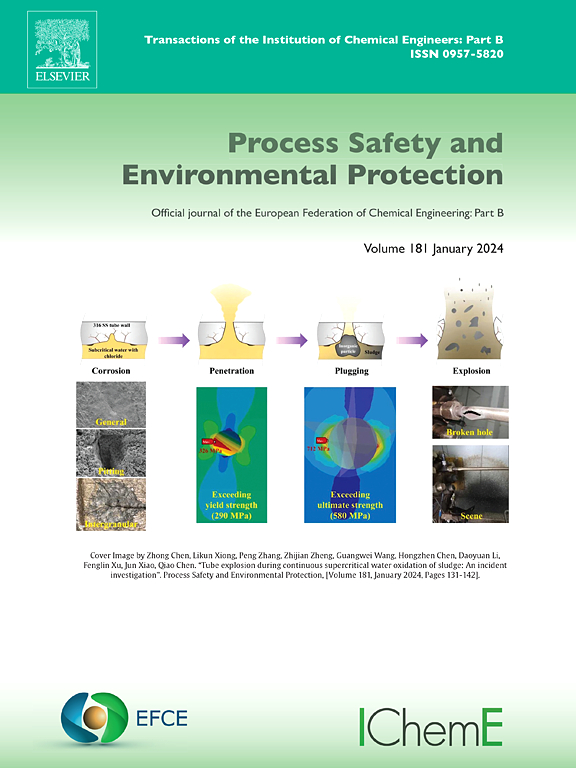Magnetic porous coal gangue-based material reduces cadmium and arsenic bioaccumulation in Brassica chinensis L. by altering the availability of cadmium and arsenic, silicon accumulation and rhizosphere bacterial community
IF 6.9
2区 环境科学与生态学
Q1 ENGINEERING, CHEMICAL
引用次数: 0
Abstract
Cadmium (Cd) and arsenic (As) possess opposing geochemical patterns in soils, leading to simultaneous stabilization difficulties in contaminated soil. Our previous study indicated that magnetic porous coal gangue-based material (MPCG) possesses excellent potential for simultaneously reducing the availability of Cd and As. However, the effect of MPCG on the uptake of Cd and As by plants in contaminated soil remains unclear. This work systematically investigated the effects of MPCG on Cd and As bioaccumulation in Brassica chinensis L. The impacts of MPCG on soil properties, Cd and As availability, bioaccumulation, and rhizosphere bacterial communities were carefully investigated. MPCG treatment significantly increased the available phosphorus(P), potassium(K), and silicon (Si) concentrations in contaminated soil while reducing available iron (Fe) concentrations. The 3 % (wt/wt) MPCG was applied to stabilize Cd and As, which could significantly decrease their availability by 15.98 % and 58.98 %, respectively. MPCG also enhanced the abundance of aioA and dsrA by 236.83 % and 129.60 %, respectively, and reduced Geobacyeraceae by 88.06 %. Moreover, the bioaccumulation of Cd and As in plant shoots was significantly reduced by 39.53 % and 49.37 %, respectively. MPCG-treated soil could also obviously reduce Cd absorption by promoting Si absorption in plants. Lastly, the plant biomass in the MPCG-treated soil increased by 48.97 %, and the Cd and As concentrations in the plant shoots met the Chinese national standard limits. This work offers insights into the effectiveness of the low-carbon MPCG treatment method on Cd and As co-contaminated soils.
磁性多孔煤矸石基材料通过改变镉和砷的有效性、硅的积累和根际细菌群落减少了芸苔属植物镉和砷的生物积累
镉(Cd)和砷(As)在土壤中具有相反的地球化学模式,导致污染土壤同时稳定困难。我们之前的研究表明,磁性多孔煤矸石基材料(MPCG)具有同时降低Cd和As可用性的良好潜力。然而,MPCG对污染土壤中植物对Cd和As吸收的影响尚不清楚。本文系统地研究了MPCG对油菜Cd和As生物积累的影响,并对MPCG对土壤性质、Cd和As有效性、生物积累和根际细菌群落的影响进行了研究。MPCG处理显著提高了污染土壤中有效磷(P)、钾(K)和硅(Si)浓度,同时降低了有效铁(Fe)浓度。应用3 % (wt/wt)的MPCG稳定Cd和As,可显著降低Cd和As的利用率,分别降低15.98 %和58.98 %。MPCG还使aioA和dsrA的丰度分别提高了236.83 %和129.60 %,使Geobacyeraceae的丰度降低了88.06 %。此外,Cd和As在植物芽部的生物累积量分别显著降低了39.53 %和49.37 %。mpcg处理土壤还可以通过促进植物对硅的吸收来明显减少镉的吸收。mpcg处理后的土壤生物量提高了48.97% %,植株枝条中Cd和As的浓度达到了国家标准。本研究揭示了低碳MPCG处理镉砷共污染土壤的有效性。
本文章由计算机程序翻译,如有差异,请以英文原文为准。
求助全文
约1分钟内获得全文
求助全文
来源期刊

Process Safety and Environmental Protection
环境科学-工程:化工
CiteScore
11.40
自引率
15.40%
发文量
929
审稿时长
8.0 months
期刊介绍:
The Process Safety and Environmental Protection (PSEP) journal is a leading international publication that focuses on the publication of high-quality, original research papers in the field of engineering, specifically those related to the safety of industrial processes and environmental protection. The journal encourages submissions that present new developments in safety and environmental aspects, particularly those that show how research findings can be applied in process engineering design and practice.
PSEP is particularly interested in research that brings fresh perspectives to established engineering principles, identifies unsolved problems, or suggests directions for future research. The journal also values contributions that push the boundaries of traditional engineering and welcomes multidisciplinary papers.
PSEP's articles are abstracted and indexed by a range of databases and services, which helps to ensure that the journal's research is accessible and recognized in the academic and professional communities. These databases include ANTE, Chemical Abstracts, Chemical Hazards in Industry, Current Contents, Elsevier Engineering Information database, Pascal Francis, Web of Science, Scopus, Engineering Information Database EnCompass LIT (Elsevier), and INSPEC. This wide coverage facilitates the dissemination of the journal's content to a global audience interested in process safety and environmental engineering.
 求助内容:
求助内容: 应助结果提醒方式:
应助结果提醒方式:


